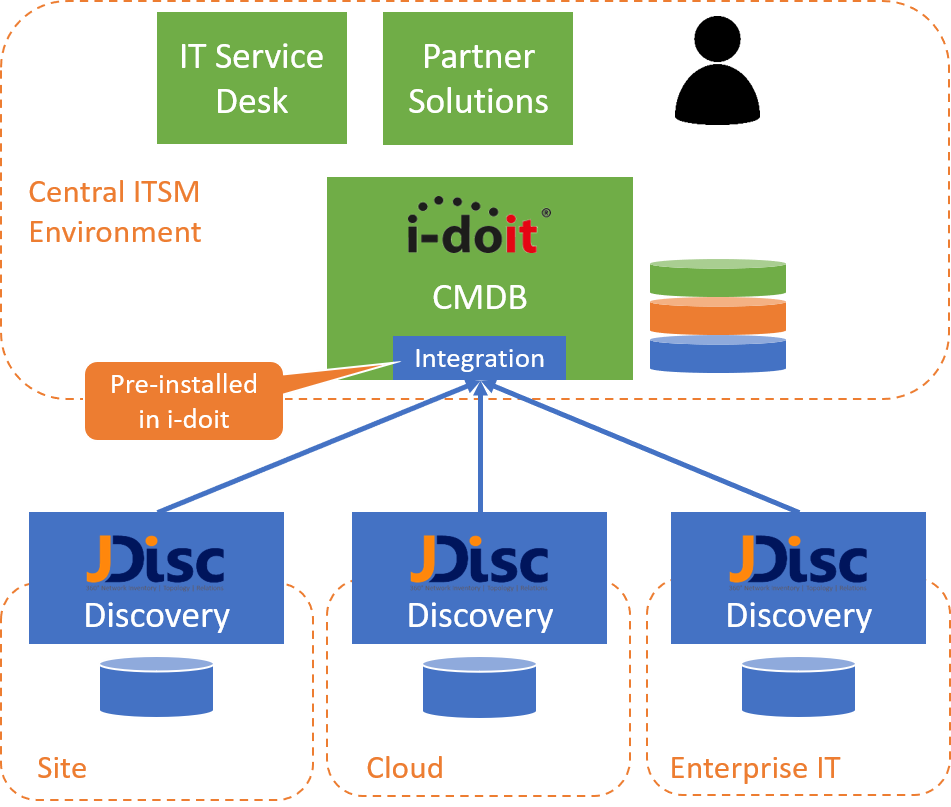JDisc Discovery & i-doit CMDB – 1 Solution, 2 Parts

i-doit is a CMDB solution with many add-ons for use cases such as IT service management, IT documentation, IT asset management and Information security management system (ISMS). Since many years, JDisc and i-doit have a close partnership to provide the capabilities of JDisc Discovery to i-doit customers. Both applications are best-of-class solutions in their space of network discovery on the one hand and CMDB on the other hand. But today’s complex problems in the enterprise IT of a VUCA world (volatility, uncertainty, complexity and ambiguity) cannot be addressed by one tool alone.
Although the marketing of some vendors might suggest that one tool can be good in many areas at the same time, this is usually not true. All solutions have a home base where they’re coming from and trying to enter new areas of expertise is not easy. Smaller companies cannot even try this, they are literally forced to be experts in their area. So JDisc does not try to do more than provide the best network inventory and discovery solution and extend its coverage of new devices and offer superior functionality in this area and this area only. i-doit provides an excellent CMDB for IT-documentation and asset management as the basis for IT service management (ITSM) processes. Partner companies are providing all the ITSM tools like service desk solutions, incident and management etc. but based on one of the best CMDBs for small and mid-sized customers. When looking at the big vendors of CMDB and discovery software they always offer a more or less integrated suite of products that try to cover both and usually have sophisticated mechanisms. But what do these mechanisms introduce? Not more value to the customer but instead a hole new level of complexity that the customer needs to grasp and manage. So wouldn’t it be easier to take simple but powerful concepts and out-of-the-box value and combine some of the best-of-breed solutions in their space to gain more value and less complexity in the end?
This is exactly what we want to show in this blog article. We want to combine JDisc discovery, leader in out-of-the-box network discovery and i-doit the simple but powerful CMDB to realize an every-day ITSM use case.
Normally one installs a JDisc Discovery server for each environment to discover the assets in this environment. This could be the enterprise IT, a DMZ, local office sites, subsidiaries or cloud environments of a company. JDisc could do the integration of these assets by itself but it is far more useful to use a CMDB for this purpose as its target is to be the single source of truth for IT asset management (ITAM). So a common setup is to use a central i-doit CMDB to collect and integrate all JDisc discovery servers in the local environments.
For this i-doit already contains pre-installed a JDisc add-on for importing data from JDisc Discovery into i-doit CMDB. So even no installation effort required, it works out-of-the-box.
In the i-doit CMDB, data collected from discovered from JDisc can then be combined with manually created configuration items (CI). These include locations, services, contacts that can be associated with the discovered servers, network devices and applications from JDisc.
Additionally, i-doit in addition to all the add-ons has a vivid partner ecosystem of partner solution for ITSM use cases. If you wonder, why you don’t find JDisc in the add-on list, the answer is simple, you don’t need an add-on, it’s already integrated, which is even better.
Use Case – Service Catalog
Based on this setup of the two plus tools, we can realize all kinds of corporate use cases, such as these:
- IT service management (ITSM)
- Configuration management
- Incident management
- Service desk
- Service catalog
- IT asset management (ITAM)
- IT documentation
- IT service monitoring
- Information security information system (ITSM)
In the following we will concentrate on one specific ITSM use case, that of setting up a service catalog. Goal is manage the portfolio of services offered by a company and link these to the assets the services are based on and have these automatically discovered by JDisc. Then start monitoring the service by using a i-doit add-on for checkmk and generate a service documentation.
A CMDB has to be very flexible and open and the value comes from what you do with it. So defining what associations you need is critical, e.g. that each service has a service manager assigned, available locations are linked or an SLA has been defined. The second most important factor is the quality of the underlying infrastructure data, as it is not viable to maintain this manually, except in very small companies. Therefore a prime quality of the data from discovery is essential for an automated operations of a CMDB, in order to avoid follow-on cost due to bad decisions based on bad data (see article on data quality in discovery).
For the practical illustration, please see the video.



